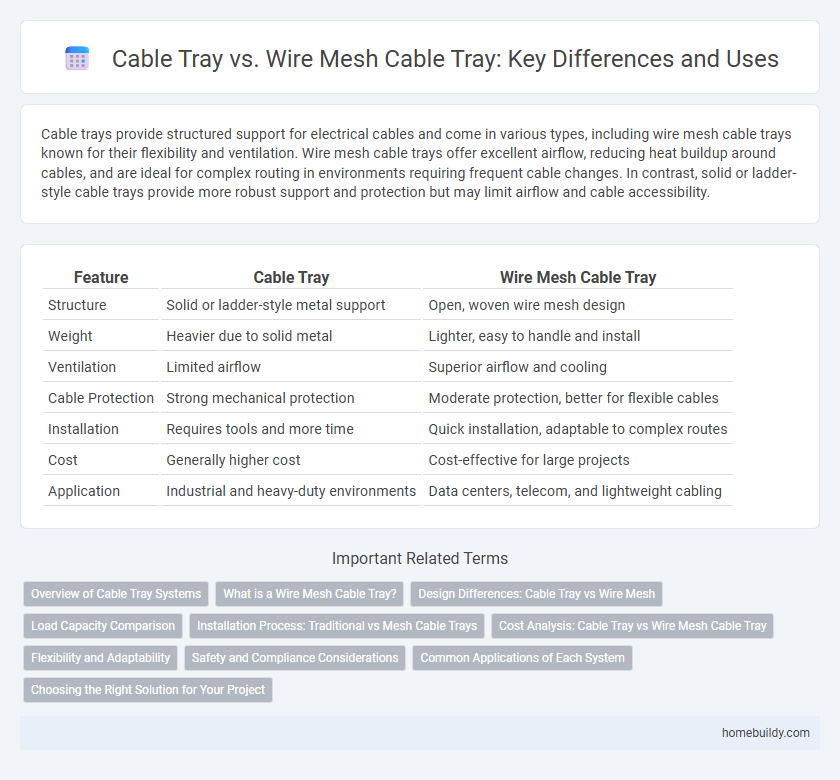Cable trays provide structured support for electrical cables and come in various types, including wire mesh cable trays known for their flexibility and ventilation. Wire mesh cable trays offer excellent airflow, reducing heat buildup around cables, and are ideal for complex routing in environments requiring frequent cable changes. In contrast, solid or ladder-style cable trays provide more robust support and protection but may limit airflow and cable accessibility.
Table of Comparison
| Feature | Cable Tray | Wire Mesh Cable Tray |
|---|---|---|
| Structure | Solid or ladder-style metal support | Open, woven wire mesh design |
| Weight | Heavier due to solid metal | Lighter, easy to handle and install |
| Ventilation | Limited airflow | Superior airflow and cooling |
| Cable Protection | Strong mechanical protection | Moderate protection, better for flexible cables |
| Installation | Requires tools and more time | Quick installation, adaptable to complex routes |
| Cost | Generally higher cost | Cost-effective for large projects |
| Application | Industrial and heavy-duty environments | Data centers, telecom, and lightweight cabling |
Overview of Cable Tray Systems
Cable tray systems offer organized pathways for electrical cables, supporting efficient cable management and ease of installation. Wire mesh cable trays, made from steel wire grids, provide excellent ventilation and flexibility ideal for complex cable runs or areas requiring frequent access. Both systems enhance safety and maintenance, with solid-bottom trays favoring heavy or sensitive cables and wire mesh trays excelling in airflow and corrosion resistance.
What is a Wire Mesh Cable Tray?
A wire mesh cable tray is a lightweight, ventilated support system made from welded steel wire or stainless steel that forms a grid-like structure to hold and organize electrical cables. Unlike solid or ladder-type cable trays, wire mesh trays offer superior airflow, reducing heat buildup and making them ideal for environments requiring enhanced cable cooling and easy cable installation or repositioning. Their flexibility and adaptability to various cable sizes and routing configurations make wire mesh cable trays a preferred choice in data centers and commercial electrical systems.
Design Differences: Cable Tray vs Wire Mesh
Cable trays typically feature solid metal or perforated side rails with a flat or trough-shaped base, offering robust support for heavy cable loads. Wire mesh cable trays consist of welded steel wires forming a grid pattern, providing superior ventilation and flexibility for routing cables in complex layouts. The open structure of wire mesh trays allows for easier cable installation and maintenance compared to the more rigid, enclosed design of traditional cable trays.
Load Capacity Comparison
Cable trays generally offer higher load capacities compared to wire mesh cable trays due to their solid metal construction and rigid design, making them suitable for supporting heavy cable bundles in industrial settings. Wire mesh cable trays, composed of interconnected steel wires forming a grid, provide moderate load capacity but excel in ventilation and ease of installation for lighter cable loads. Selecting between these two depends on the specific load requirements and environmental conditions of the installation site.
Installation Process: Traditional vs Mesh Cable Trays
Traditional cable trays feature solid metal or perforated surfaces that require precise alignment and securing during installation, often demanding specialized tools and longer labor time. Wire mesh cable trays offer more flexibility with lightweight, modular components that are easier to cut and adapt on-site, reducing installation duration and complexity. Choosing between traditional and mesh cable trays depends on project requirements, with wire mesh trays favored for installations needing quick adjustments and improved ventilation.
Cost Analysis: Cable Tray vs Wire Mesh Cable Tray
Cable trays generally offer a more cost-effective solution for large-scale electrical installations due to their sturdy construction and ease of installation, which reduces labor costs. Wire mesh cable trays tend to be more expensive upfront because of their material design and manufacturing process but provide superior flexibility and ventilation, potentially lowering long-term maintenance expenses. Evaluating total project costs requires balancing initial investment against factors like durability, installation labor time, and future accessibility for cable management.
Flexibility and Adaptability
Cable trays offer superior flexibility in supporting heavy cables and can be easily customized for complex routing in industrial settings. Wire mesh cable trays provide enhanced adaptability with their lightweight design and open structure, allowing for better ventilation and quick installation in dynamic environments. Both systems optimize cable management, but wire mesh trays excel in scenarios requiring frequent modifications and rapid deployment.
Safety and Compliance Considerations
Cable trays provide robust support and ventilation for heavy cable loads, often preferred in industrial settings due to their durability and compliance with strict electrical codes such as NEC and IEC standards. Wire mesh cable trays offer enhanced airflow, reducing heat buildup and minimizing fire hazards, which aligns well with OSHA safety requirements in commercial installations. Both types must meet grounding and bonding regulations to ensure electrical safety and prevent potential hazards in various environments.
Common Applications of Each System
Cable trays are commonly used in industrial and commercial installations for routing large bundles of heavy or high-voltage cables, offering robust support and easy access for maintenance. Wire mesh cable trays are often preferred in data centers, telecommunications, and cleanroom environments due to their superior ventilation, flexibility, and lightweight design, which help prevent overheating and allow for quick cable changes. Each system's application depends on factors such as load capacity, environmental conditions, and the need for airflow around the cables.
Choosing the Right Solution for Your Project
Cable trays provide robust support for heavy cable loads, offering excellent durability and ease of installation in industrial environments. Wire mesh cable trays excel in flexibility and ventilation, ideal for managing complex wiring routes and preventing heat buildup in data centers. Selecting the right solution depends on project requirements such as load capacity, airflow needs, and installation complexity to ensure optimal cable management and system performance.
Cable tray vs Wire mesh cable tray Infographic

 homebuildy.com
homebuildy.com